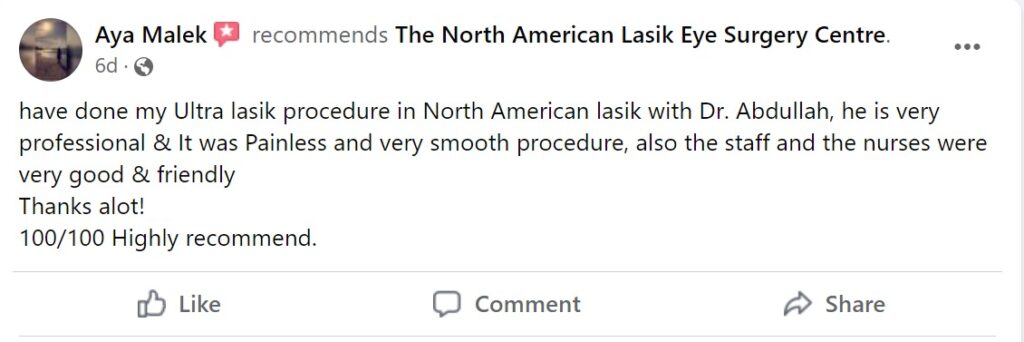Many people would like to get Lasik eye surgery but often wonder does lasik hurt? Lasik is the procedure where they reshape your cornea so you don´t need to wear glasses anymore. It is a treatment that has been done to over 6 million people worldwide.
The LASIK procedure will leave you awake and alert, but you should experience only minimal discomfort during or after the procedure.
Before the surgery begins, your doctor will use numbing drops. Then the doctor will use the laser to reshape your cornea without causing you any discomfort.
Real patients reviews on “Does Lasik Hurt?”




Does LASIK eye surgery hurt?
LASIK eye surgery does not cause any pain. During your procedure, your surgeon will place numbing drops in both of your eyes before your procedure. The procedure shouldn’t cause you any discomfort, but you may feel some pain.
For your calm and relaxation throughout the procedure, your surgeon may also administer another medication, such as Valium. A mild itch or burn may occur after surgery, but it should subside quickly
What Does the Lasik Procedure Feel Like?
When your surgery begins, the eye (or eyes) being operated on will be numbed with eye drops containing a local anesthetic. This procedure may cause mild discomfort, but there should be no pain.
The numbing drops will prevent pain while your eyes are reshaped. While you may see dimmed lights while your eyes are reshaped, you will not feel discomfort. Whether you want one or both eyes treated, anesthetizing eye drops will be injected into one or both eyes during the LASIK procedure.
● Follow your doctor’s instructions regarding your medications and eye drops.
● Never put old contacts back into your eyes, whether they are difficult to see or not.
● Never rub or poke your eyes, no matter what you feel is inside.
● Within two weeks of the procedure, avoid applying makeup, lotions, or creams to the area around the eyes.
● Avoid swimming and hot tubs for one or two months.
● Do not play contact sports or engage in activities involving high contact levels for at least four weeks.
Follow-up appointments are important, so the eye doctor can evaluate your healing progress and prescribe you with any needed medication.
What Are the Signs I Am a Good Candidate for LASIK?
“The good news about LASIK is that it’s fairly inclusive, meaning many adults are eligible for this procedure,” explained Regina H. Altemus, MD, assistant professor of ophthalmology at Penn Presbyterian Hospital. FDA-approved LASIK parameters require patients to meet the following criteria:
- Irregularities of the eye up to -12.00D, also known as nearsightedness or myopia.
- As much as +6.00D of hyperopia, commonly referred to as farsightedness.
- You can have up to 6 diopters of astigmatism (cylinder), an imperfection in your eye’s curvature.
LASIK should only be performed after a comprehensive examination by an eye specialist. During the initial consultation, your doctor will determine your corneal shape, thickness, and pupil size to determine if you have refractive errors such as myopia, hyperopia, astigmatism, or other eye conditions. To prevent dry eyes following surgery, your doctor may suggest preventive treatment in addition to checking your eyes’ moisture.
Requirements To be a good candidate for LASIK
- The minimum age to be a good candidate for Lasik is 18 years.
- After surgery, it may be more difficult to heal if the patient does not have an autoimmune disorder.
- Breastfeeding or being pregnant is not permitted. Hormones can affect the shape of your eyes during pregnancy, so it is best to wait until normal hormone levels return before undergoing surgery.
- No glaucoma, cataracts, chronic dry eye, or glaucoma history.
What is involved in LASIK eye surgery?
With LASIK eye surgery, images are better focused onto the retina by reshaping the cornea. With the help of two lasers, this effect can be achieved. There are multiple options for LASIK eye surgery which include Ultra Lasik, Femto Lasik and ReLEx SMILE.
You can expect the following results after LASIK eye surgery:
- A doctor will verify your eye health history during the eye health test.
- Your eyes will be numbed with numbing eye drops, and a sedative will be administered.
- A femtosecond laser creates your cornea with a thin circular flap. The flap will then be folded back, allowing your surgeon to access the stroma or underlying cornea.
- Cool ultraviolet lasers are capable of removing small amounts of corneal tissue. This enables it to focus light on your retina for more accurate vision.
- Your cornea will be flattened if you are nearsighted. Farsighted people will have steeper corneas created by the laser.
- After removing the corneal tissue, the flap will be laid back to cover the eye.





